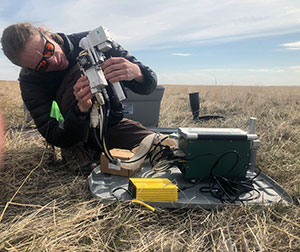UW Helps Some Eastern Wyoming Farmers Test New Intermediate Wheatgrass
Published June 04, 2021

Some eastern Wyoming farmers nosed their tractors into fields this spring pulling drills planting a new variety of intermediate wheatgrass that may negate Wyoming’s fussy weather and bolster bottom lines ravaged by falling organic wheat prices.
Four producers have planted experimental plots of Kernza, says Hannah Rodgers, a Ph.D. student involved in the project in the University of Wyoming’s College of Agriculture and Natural Resources.
Kernza is a perennial, unlike wheat, which is an annual and does not regrow after harvested. Once cut or harvested, Kernza regrows. The variety can be used as a forage crop or, if left longer, can be harvested for grain. The perennial crop will develop and support microbial life and sequester more carbon.
The Salina, Kan.-based Land Institute developed the variety.
“It’s super new and only grown in a few places,” says Rodgers, including California, Kansas, Minnesota and Nebraska.
But never in Wyoming.
“We thought Kernza might be uniquely suited to Wyoming because the state has such a harsh environment,” Rodgers says.
Kernza is harvested for grain in wetter states and then keeps growing. “You might cut it for grain and then graze it later in the summer,” she says. “Nobody has ever planted it anywhere this dry. So, it’s really an experiment.”
A beer and cereal are the main products currently made from Kernza.
Parts of eastern Wyoming are known for growing organic wheat, usually in a fallow cropping. Farmers say soil degradation is happening, prices are dropping, and farmland is being abandoned for other uses, such as grazing -- “which is important,” Rodgers says. “But maybe less valuable.”
The $75,000 Western Sustainable Agriculture Research and Education grant has several parts. UW Extension soils specialist Jay Norton will compare soil health with Conservation Reserve Program fields. Alex Fox, another Ph.D. student on the project and working with Brent Ewers in the Department of Botany, is taking plant measurements, such as photosynthesis and water use throughout the growing season, to see Kernza’s water consumption compared to wheat. Rodgers will study soil fertility and microbial communities and carbon sequestering, and Tom Foulke, an extension senior research scientist, will examine if the crop may benefit producers economically.
Mimicking native prairies, composed mostly of perennials, drove the variety’s development, Rodgers says. Perennial plants build soil health year-round.
“It’s less input intensive or fossil fuel intensive,” she says. “You can plant it and sort of forget it about it. You don’t have to till the soil every year, and you don’t have to plant every year, so there are way fewer tractor passes.”
The kernel is smaller than wheat, she says. Wheat is selling for about $5 a bushel and Kernza about $5 per pound. A bushel of wheat is about 60 pounds.
The crop is planted in rows like wheat. Many farmers had already heard about Kernza and already had an interest in it, she says.
“Farmers around here have a ton of experience planting intermediate grass,” Rodgers says. “When we delivered seed a few weeks ago, several of them looked at it and they were, ‘Oh, yeah, this is intermediate grass. I know how to plant this, and I have the drill for this.’”
The crop is typically planted in the fall like winter wheat, but Wyoming producers say the crop does better if planted in the spring. There will be no harvest until next summer.
This spring’s massive snowstorm that battered eastern Wyoming may help jump-start the crop, which Rodgers says can be hard to establish.
Two farmers planted Kernza into dryland fields around Chugwater, and two planted into irrigated land near Pine Bluffs. The grant pays for seeding 10 acres per farm, “but all four of the farmers decided to plant more than that,” she says.
The farmers were all-in when approached. “They were like, ‘I was wondering when somebody was going to do a Kernza thing, because we’ve been hearing about it, and we think it would be great for here,’” Rodgers says.
Acreages are 16, 20 and 80 acres. An additional test plot is at UW’s James C. Hageman Sustainable Agriculture Research and Extension Center near Lingle.
Three of the farmers had already planted Kernza when Rodgers got a call from another wanting to know how to get seed.
“And then he went ahead and put in 80 acres,” she says. “It’s so early in the Kernza world. It’s hard even for farmers to get seed to learn anything about it without somebody coordinating things. So, we are fortunate that Tessa Peters, The Land Institute’s Kernza commercialization manager, lives in Laramie.”
Peters received her bachelor’s degree in agroecology from UW and a Ph.D. in plant breeding and plant genetics from the University of Wisconsin-Madison.

